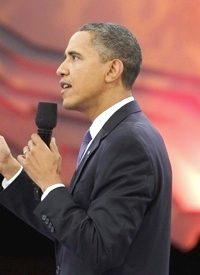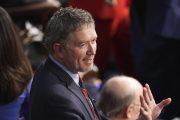
President Obama indicates that he and his aides have outlined an agenda for after the midterm elections on November 2, one that will be “bipartisan,” and will focus on cutting the deficit, overhauling No Child Left Behind, and passing further free-trade pacts.
The New York Times reports: “Mr. Obama came to office vowing to reach across the aisle and change the tone in Washington, a goal he quickly abandoned when Republicans stood in lockstep against his stimulus bill. Today, with each side blaming the other for their sorry state of relations, neither has ‘clean hands,’ said Senator Mark Warner, Democrat of Virginia.”
Bill Galston, former domestic policy advisor to President Bill Clinton, remarked, “Probably the biggest single promissory note he handed out during his campaign was the promise of trying to overcome Red America and Blue American into one America.”
Though the President vowed he would have “monthly meetings with both Republican and Democratic leadership,” he has failed to hold up his end of the bargain, having held only five meetings. One such session was the televised health care summit.
When accused of failing to live up to his promise of bipartisanship, Obama asserted that while he has “repeatedly extended his hand,” Republicans “made a political decision” to oppose him consistently.
Obama’s communications director, Dan Pfeiffer, remarks, “That was their choice. Hopefully they will make a different one after the election.”
Galston contends, “I think the perception is that he didn’t work as hard as he could have to redeem that note, and I can’t believe that he wants to go down in history as the president who promised to overcome polarization and ended up intensifying it.”
Critics may take issue with allegations that it was the Republicans who prevented bipartisan efforts, as some contend it was the President’s left-wing agenda that created insurmountable odds for bipartisanship.
Yet despite Obama’s newest announcement to launch a bipartisan effort after the midterm elections, it seems that may not be the case. For example, according to the President’s education secretary, Arne Duncan, revamping No Child Left Behind could be a monumental, and at times contentious, task, as it would involve repairing “the current state of anger and animosity.”
Duncan reports:
I’m a big believer in less of singing "Kumbaya" together and going on retreats than in rolling up our sleeves and doing work together … That’s how you build respect, that’s how you build trust, that’s how you build relationships. I think it’s a way to move beyond some hurt feelings on both sides. Do it through the work.
To boot, if any of the predictions for the lame duck session come to fruition, partisanship in the White House under President Obama may be permanently sealed. Several Democrats are planning to pass a variety of controversial pieces of legislation, including the defense authorization bill, which contains provisions to provide amnesty to illegal aliens.
Another bill awaiting the lame duck session is one that will legislate food safety and child nutrition.
While the list goes on, the most important item that the lame duck session will witness is the end to President Bush’s infamous tax cuts.
The passage of any of these controversial bills will likely hinder any hope of bipartisanship.
Democrats remain hopeful that they will remain in the majority after November 2, while others have indicated an intent to reach out to the GOP. The New York Times writes, “Senior advisors to Mr. Obama insist they are focused on keeping Democrats in the majority, and they will not detail their post-election strategy — either for legislation or mending fences. But privately, allies of the White House say Mr. Obama’s new chief of staff, Pete Rouse, who had good relations with Republicans when he worked on Capitol Hill, is thinking about how Mr. Obama might reach out.”
Of course, much of Obama’s post-election agenda will depend upon the results of the elections. If the Tea Party candidates are elected to office, Republican leaders may be more heavily influenced by the presence of the Tea Partiers than by any desire to engage in a bipartisan effort.
Likewise, if the results are as predicted, and Republicans win the majority of the House while the Democrats maintain the majority in the Senate, bipartisanship seems implausible.
Some speculate that the President will follow in the footsteps of former President Bill Clinton and move toward the center.
Republican Senator Orrin Hatch has indicated, “If he did turn to the center, as Bill Clinton did, I think there would be a lot of hope, but right now nobody knows what he is going to do.”
For some of the more conservative candidates, “center” may not be enough. Many, such as Kentucky’s Republican Senatorial candidate Rand Paul, are calling for a total return to the ideals put forth in the Constitution.
Republican Senator Mike Johanns asserts that the President needs to make a greater effort to reach over the aisle. “He needs to build friendships and he needs to build trust.”
The writer of a Time magazine article carried by Yahoo News recommends that the President make some personnel changes following the elections to help foster a bipartisan effort, unite with the GOP on common causes such as deficit reduction, confront Republicans when they overreach, and stand up to his own party when it becomes too liberal.
The decisions made by the President following the midterm elections may very well determine the outcome of the 2012 presidential election.
Photo: President Barack Obama speaking to young people during a town hall event broadcast live on October 14, said. "My hope is that as we look forward, let’s say on education or on energy, some of the things that we haven’t yet finished, that we’re going to have a greater spirit of cooperation after this next election.": AP Images




